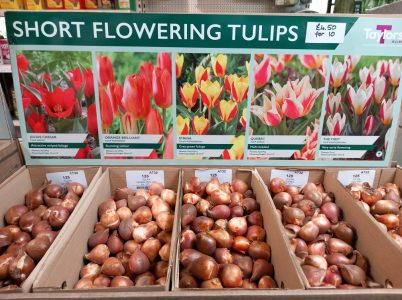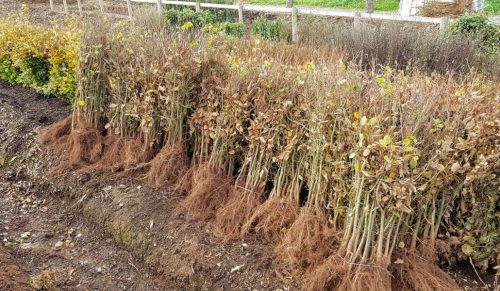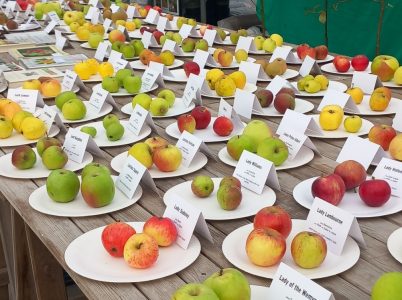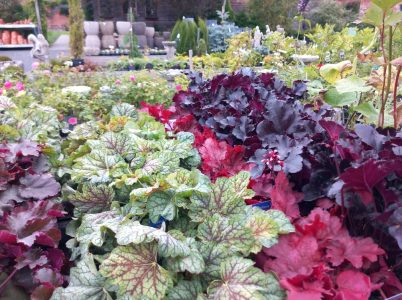Gardening
Christmas Plants for sale
We have a lovely range of Christmas plants for sale to brighten up your home or garden for the winter – ideal as gifts or just as a treat to yourself. The Plant Centre shop is absolutely bursting at the seams with temptation! My highlights are:
- Indoor Cyclamen. We have a few choices here in lots of different colours. Choose from Mini Cyclamen with bright red flowers at £3.99 each, Midi Cyclamen in mixed colours at £4.99 each or 3 for £12 or Large Flowered Cyclamen at £8.99 each. Look out too for a new variety – Cyclamen Exclusive. These are very distinctive with flared petals on downward facing blooms with contrasting paler sepals giving a unique appearance. These are a new variety, developed in the Netherlands, and new to Woodside and are £6.99 each. Keep all indoor cyclamen in a cool place indoors, and water sparingly and only when required. Some garden centres sell mini and midi cyclamen as being hardy, but don’t be fooled – we are completely honest with you and know that in our area these cyclamen are not suitable for outdoors but are superb indoor plants. If you’d like outdoor hardy cyclamen, please just ask – we have plenty of these too and they do well under deciduous trees and shrubs.
- Indoor Hyacinths. These are well known bulbous plants which are grown both for their colour and for their unmistakable scent. We have them in a very attractive rustic arrangement with a wooden Christmas tree (which need to be seen to be appreciated) which would make an ideal present. We also have a new variety to us – Hyacinth Multiflora – in shades of pink, blue and white. These consist of a lot of shoots coming out of a single bulb, and so gives multiple blooms to one pot. They are showing buds just now and look like they are going to give a wonderful display in time for Christmas, or just after.
- Waxed Amaryllis. Our last batch sold out very quickly, so we now have some more in stock – this time they are wearing a cosy Christmas jumper! These are specially selected and tested Amaryllis bulbs which need no water or compost to produce flowers. They have a swirl metal base to provide stability and will sit on your windowsill just as they are, and will produce flowers on compact stems, and so are unlikely to become top-heavy and topple over. They make an ideal gifts to people who have limited gardening ability and are very rewarding to grow.
- Orchids – Phalaenopsis. These are also known as Moth orchids and are the most popular and easy to grow indoor variety and we have them in a mix of colours. They are in flower and bud now, and will bloom for weeks, and at just £11.99 they are far better value for money than a bunch of flowers, as you can keep them once they’ve finished flowering, and coax them back into bloom again and again. They do well on a light windowsill but away from full sun, and thrive in bathrooms and kitchens with the extra humidity. They are also very tolerant of central heating, unlike many other indoor plants.
- Christmas Cactus – Schlumbergera. These are striking houseplants which burst into flower over the festive period creating a brilliant display of colourful blooms. They are easy to care for, thriving in moderate warmth and evenly moist compost, being careful not to overwater. Position on a bright window sill away from direct sunlight for weeks of flowers.
- Narcissus Tete a Tete – Miniature Daffodil. These are very popular spring flowering bulbs for the garden, but also can be forced on indoors for mid-winter colour. We have them available planted up in bowls suitable for growing indoors to give a bright splash of cheeriness. Ideal as a gift, or as an eye-catching display in your own home
Outdoor plants include winter flowering Heathers, Christmas Roses (Hellebores), Skimmias, Leucothoes and Gaultherias, and much, much more. There’s really no excuse to not have a good display of winter interest plants in your garden with the choice of plants we currently have in stock!
Christmas Trees Have Arrived
Our Scottish grown cut Christmas trees for sale are all Nordmann Firs, which are the non-needle-drop variety. As with all cut Christmas trees they do best in a cool room and away from heat sources – if you’re not ready to put yours up just yet (after all it is still November!) then keep in a cool place such as a garden shed and stand in a bucket of water. Nordmanns are well known for their bushiness, good shape and lasting qualities. We have them in sizes from 4ft to 7ft, and our prices are:
4ft £42
5ft £55
6ft £70
7ft £90
If you’d like one reserving (even if your’e not ready for it yet) call us on 01835 830315 and we’ll set one aside for you.
Living Christmas Trees for sale
If you would rather have a living Christmas Tree, we have a good stock of Picea glauca Perfecta, which is a naturally conical shaped Spruce, and these are perfect for table top trees. These are gorgeous trees which have been professionally grown by one of our shrub growing nurseries and are outstanding value for money at £24.99 for the smaller size (approx 1m) and £36.99 for the larger size (approx 1.3m). They are suitable for planting outside in the garden or in a bigger pot after Christmas and will make a nice upright evergreen feature in your garden.
Christmas Wreaths
We have started making our Christmas Wreaths a bit earlier this year, due to demand. All our wreaths are made using locally picked natural fresh conifer and holly, and are suitable for doors, gates or for the cemetery. Our smaller size is usually used for graves and we can decorate them with cones, artificial white hellebores, or artificial red roses. These are £22 each. Our door wreaths are a bigger size and come with a colourful bow, and prices start at £30. We also do small swags to order at £16. We try to keep up and have stock available for sale, but recommend that you phone to reserve yours, just in case we run out. Please call us on 01835 830315 to reserve yours and let us know what date you would like your wreath and we can have it freshly made for you.
Raspberry Canes in Stock
Our Scottish grown raspberry canes are now in stock at Woodside, ready for planting now.
Based in Perthshire, Eastern Scotland, James McIntyre & Sons have been specialising in the production of soft fruit plants for over 60 years. They now produce over a million raspberry canes every year from 60 acres of ground located within the beautiful town of Blairgowrie, in the Strathmore Valley, as well as growing other soft fruit plants on the nursery, such as Loganberries, Gooseberries and Currants – all also available to purchase at Woodside.
The varieties of Raspberry canes we have in stock are:
Allgold – a very reliable autumn fruiting variety with tasty small yellow berries
Autumn Bliss – a red berried autumn variety, fruiting from late August until the first frosts, and doesn’t require support
Glen Ample – a mid season variety with heavy crops on spine-free canes, and with good disease resistance
Glen Clova – an early fruiting variety (July) with small but flavoursome fruits which freeze well
Glen Ericht – an early variety with good disease resistance. Sharp flavour so excellent for jam making
Glen Magna – a late summer variety with large sweet fruits, and good resistance to disease and aphids
Glen Prosen – a mid season summer variety with extremely high yields of good quality firm fruits on spine free canes
Malling Admiral – a strong growing mid-season variety with large flavoursome berries, on almost spine free canes. Good disease and virus resistance so good for organic growers
Malling Jewel – a traditional favourite mid season variety with good virus resistance
Malling Leo – a late fruiting summer variety perfect for extending the picking season. Tall vigorous canes with good disease resistance
Malling Promise – an vigorous and abundant early variety with firm fruits
Tulameen – a modern late summer fruiting variety with reliable high yields, suitable for growing in a large container and can be trained up a trellis or obelisk.
In addition we have also had a new delivery of Honeyberries. These are members of the honeysuckle family and originate from Siberia so are very hardy. These are easy to grow shrubs producing attractive blue berries with a zingy flavour and packed full of goodness. They need to be planted in two’s for pollination and all our varieties (Blue Banana, Boreal Beauty and Boreal Blizzard) will act as pollination partners for each other.
Bulb Planting Season
Don’t forget that this is bulb planting season. Planting conditions for bulbs and plants are good at the moment with the recent rain giving us some much needed moisture in the soil. Whilst some of our varieties have already sold out, we still have plenty left to create a good splash of colour in spring.
Eye-catching bulbs
Here are just some of the bulbs that are particularly eye-catching and a little bit unusual
- Tulip Finola – large blousy pink peony-like blooms
- Fritillaria meleagris – the popular Snake’s Head Fritillary. Perfect for naturalising in grass or in informal borders
- Hyacinthoides non-scripta – our beautiful native British Bluebell. Great for woodland gardens and for planting underneath deciduous trees and shrubs
- Narcissus Mixed Butterflies – gorgeous frilly daffodil flowers with flared trumpets in pretty shades of cream and yellow
Alliums
I’m a huge fan of these stately flowers which are in the same family as chives and onions. We have several varieties to choose from:
- Gladiator – giant purple heads upto 20cm diameter on stems around 1m in height
- Mount Evereste – a strong form with white flowers
- Globemaster – another tall purple variety with large flower heads
- Schubertii – dramatic loose heads of metallic pink lowers which have a star-burst like effect
- Purple Sensation – the most popular and relaible purple alliums growing to around 60cm high
- Christophii – Loose clusters of pinky purplish flowers on stems around 60cm high
Or if you can’t decide which to grow, we have packs of mixed alliums which are excellent value at £5.99 per pack of 12.
All Alliums need a well drained soil in full sun, and are very good for pollinating insects such as bees and hoverflies. They make a dramatic display in the garden with their distinctive globe shaped clusters of flowers that are carried high above strap-like foliage.
I think they work brilliantly in a herbaceous border, where the sometimes scruffy leaves are covered by the growth of the herbaceous plants, allowing the flowers to tower above them. Many years ago I took a group of gardeners on a trip to Highgrove House, and we saw probably the best display of Alliums ever – in a grassy meadow amongst the buttercups. There must have been thousands of Alliums planted there and what a planting combination! We don’t all have the luxury of being able to plant on this scale, but even a small group of alliums in your garden will create a wonderful and long lasting display.
Orders Welcome for Bare Rooted Hedging
Our bare rooted hedging price list and order form is now ready.
You can open the form by clicking here or you can collect one in person from Woodside. We do not carry bare-rooted stock at Woodside, so all requirements for heding must be pre-ordered and paid for using the form.
Buying hedging as bare-rooted plants (that is without compost or pots) is much more cost effective than buying them as potted plants. While container grown plants are available all year round, bare-rooted plants are only available during the dormant season, usually November to February, when they are lifted from the ground with the minimum amount of disturbance to them. Once received plants should be planted as soon as possible to prevent the exposed roots from drying out, or if that’s not possible they can be heeled in to a spare patch of ground ready to be transplanted into their permanent position at a later date.
Some evergreen hedging plants such as hollies and Leylandii are best purchased as potted plants, as they can dry out very quickly without the protection of compost, and so are unlikely to plant out successfully. Deciduous plants suitable for planting as bare-rooted plants include hawthorn, sloes, beech, hazel, wild roses, and hornbeam. A good mix of plants can provide a thriving hedgerow habitat for wildlife fairly quickly after planting.
How to plant bare rooted hedging
In general, I would recommend that bare rooted hedging plants are planted at a maximum of 3 per metre (about 1ft apart) for a single row. If you are looking for a thicker hedge, then a double staggered row is the way to plant them – this means you need 5 per metre.
To plant, you need to prepare the ground thoroughly; your hedge will be there for a long time and this will be your only opportunity to improve the soil. Clear the site of weeds, and dig over well, removing any weed roots. Use a garden line to dig out a straight trench about 25cm deep and add a good weed-free compost (either your own home-made compost or a bought bagged one such as Rose Tree and Shrub planting compost) and well-rotted manure, and fork into the base of the trench. Return the soil to the trench, adding a good handful per metre of Bonemeal or Growmore.
Separate your bundles of hedging into individual plants, and place in the trench, adding a sprinkle of Rootgow to the base of each plant. Firm down the soil well around the plants, and water them in. You also need to be prepared to water them regularly for the first year during dry spells, just until the roots get established.
If you need any advice on hedging plant selection, just give us a phone on 01835 830315, or visit Woodside and have a chat to us.
Rescheduling of BOG Apple Festival at Woodside
Due to Storm Amy, our annual Apple Festival to be held this weekend has now been rescheduled until next weekend 11th & 12th October 2025. There will be the same apple themed activities, appley food and drink, an amazing display of local apples, trade stands and information stalls as planned – just hopefully better weather! The event will run from 10am – 4pm on both days, and has FREE admission and FREE parking.
Please note that if you able able could you park at nearby Harestanes Visitor Centre and take the short walk through the trees to Woodside. This will leave our car park available for those less mobile, and for the collection of purchases.
Onion Sets in stock now
Our autumn planting onion sets have just arrived and we are selling these loose by weight, so you can purchase as few or as many as you would like.
Choose from Autumn Champion or Red Winter.
Our recommended shallot for autumn planting is Shallot Jermor, and that is ready too.
How to Grow Autumn Onions
Onion sets are small immature onions, which have been grown from seed in the previous year, and then harvested early so that they can be planted out a later date. Autumn planted sets will provide the grower with a distinct advantage of an early harvest in the following year.
Onions can be grown in beds or containers. Growing onions from sets in containers is ideal for those who want a small, steady supply of bulbs as and when needed, with any surplus being dried and stored for later use. Make sure that the pots selected have good drainage holes, and raise them up on pot feet to prevent waterlogging. Fill large pots or containers with good quality compost such as Growmoor Vegetable Compost. Firm the soil surface and apply water with a watering can and rose attachment. Use a dibber or gently push the sets into the soil, at 10cm spacing, so that only the tips are visible. Place the container in a sunny position.
Prepare planting beds, usually after other main crop vegetables have been harvested, and incorporate plenty of organic matter. Onions will grow best in well-drained soil in a sunny position. Rake the surface soil to a fine tilth and firm with the back of a rake. Push the sets into the soil so only the tips are showing. Space each set at 10cm apart in the rows and 30cm between the rows. If the birds pull them out, just keep pushing them back in until the roots are sufficiently formed to anchor them on place.
If the autumn is mild then the sets will begin to show signs of growth with green shoots appearing. Onions are very hardy but if early hard frosts are forecast then ensure these young shoots are protected with frost fleece. Water sparingly and only if the soil dries out, otherwise they should over winter without any problems. Water as normal when temperatures rise during late spring.
Over winter, the onions will be dormant and pests and diseases will be less troublesome. Come the spring, look out for signs of yellowing leaves, rust, mildew and mould. Avoid feeding young plants with nitrogen-rich fertilisers. Onion fly is a known pest but rarely affects plants grown from sets.
Autumn planted onion sets should be ready for harvesting from early June in the following year, which is 2-3 months ahead of spring planted sets. Store in a cool dry place.
Grow Your Own Garlic
Our first batch of garlic is also now in stock – Elephant Garlic in pre-packs. If you haven’t tried growing garlic before, here is our How to Grow Garlic Guide
Other varieties will become available in the next few weeks. We always sell out of these very quickly so don’t delay.
Gardening Tasks for September
The wonderful summer weather has been a joy to us all, but also a challenge for gardeners as our plants begin to flag in the absence of significant rainfall. This has really emphasised the need for feeding and mulching, in order to keep plants strong and healthy during stressful dry periods, and to trap as much moisture in the soil as possible. This is something to remember as we edge towards autumn and winter as mulching is just one of the gardening tasks for September.
New Planting Season
September is a very busy month in the garden, and marks the start of a new season of planning, tidying up and planting for autumn interest. Perennial plants such as heathers and heucheras put on a good display in the later part of the year and, supplemented with bedding plants like violas and pansies, will make a colourful splash in the autumn and right through to the spring. Bedding cyclamen are also looking good at this time of year, but bear in mind that these are not hardy in the Scottish Borders, and will die off when the first frosts arrive.
Plant up Winter Pots
Now is a good time to plant up autumn and winter pots. Dwarf conifers are a good option as a centre-piece in pots as these come in a variety of leaf forms and shades ranging from blue-grey to deep green and are very hardy. Remember to use fresh compost as the old compost will have had nutrient depletion throughout the summer. Make sure that drainage holes in the pots are open by raising them on pot feet and putting crocks or stones in the bottom of the pot. At Woodside we recommend using Growmoor Multi-purpose Compost with Added John Innes – it’s the one we use for all our re-potting.
Care for Summer Bedding
Summer bedding plants in hanging baskets and pots will keep going until the first frosts. Hopefully you have been keeping up with watering and feeding them over the summer – if so, they will still be looking good. Remember to continue to feed them with a liquid feed and to keep dead-heading them. My pots and hanging baskets at home have never been better – they have really enjoyed the summer sun, and weekly feeding has ensured that there are always fresh flowers.
Refresh your Perennial Borders
Out in the garden, it’s a good time to assess whether you have enough late-flowering perennials to keep the garden looking good, and to provide a nectar source for pollinating insects into the autumn. Any gaps can be filled with Sedums, Echinacea and Rudbeckias which can all be planted at this time of year. Congested clumps of perennials, such as hardy Geraniums and Hemeracollis can be lifted, divided and replanted to keep them heathy and fresh.
Plant Spring Bulbs
September is a good month for planting spring flowering bulbs, such as crocuses, snowdrops, daffodils and fritillaries, both in the garden and underneath autumn bedding plants in pots. Why not try planting up an Allium border? These are members of the onion family and have striking rounded heads of flowers, usually in blues and purples and sometimes in white, which are loved by bees and other beneficial insects. The foliage can look very scruffy, so I’d always recommend to plant them amongst perennials which will hide the foliage but allow the flower spikes to emerge above them.
Vegetable Garden
In the kitchen garden you can still plant hardy greens, such as pak choi, kale, broccoli and spring cabbage – remember to protect against pigeon damage by using micromesh or netting.
Prune out all the fruited canes of summer raspberry canes by cutting them right to the base and tie in thenew canes to supports.
Plant fruit trees like apples, pears and plums while the ground is warm – making sure to water all new plantings in well.
More Vintage Garden Products in Stock
We’ve been to three auctions in the last seven days, so Stephen has a lot more of his salvage and vintage garden range of products available now.
We are particularly pleased with a pair of late 18th Century/early 19th Century carved sandstone urns which are absolutely gorgeous, with excellent weathering, and have a really good look about them. We hardly ever get the chance to purchase urns of such age and quality and they came out of a farm garden near Carlisle where they had been for as long as the owner could remember. These are priced at £1850 for the pair. For more information about the urns click here.
Look out too for a vintage railway bench of approximately 3m in length which could comfortably seat six people. Its a Colebrookdale style bench in the branch form, with timber which could do with some renovation, and is currently painted in an attractive bright blue. It’s priced at £650. To see more of our vintage garden furniture, click here.
From a private garden in Northumberland we have purchased a pair of cast iron urns on plinths which are a real statement piece, standing around 1.5m high in total. They are really stunning and would work in a small courtyard as well as in a grander scale garden. We have these at £1950 for the pair of urns and the matching plinths
For a smaller budget we have also got lots more tools and knick-nacks for the garden shed, so do pop in and have a look in our blue shop to see the full range. There’s bound to be something that will come in useful!
We look forward to seeing you soon.
Hooray for Herbaceous Plants
It’s the time of year when our gardens are looking bright and colourful, with many herbaceous plants at their best. They are doing particularly well this year after enjoying a warm and sunny spring and the early summer rain.
At Woodside we have a great range of herbaceous plants – these are flowering plants that die down for the winter and then come back year after year. Some of my favourites are recommended below:
Hemeracollis – Day Lilies. These are some of the easiest plants to grow and have masses of showy lily like blooms. We have available Cathy’s Sunset (Orange), Parden Me (Crimson), Edge Ahead (Pink) and Stella d’Ora (Yellow). Plant in a sunny spot in any garden soil that doesn’t waterlog.
Hardy Geraniums – these are looking wonderful in my garden at home just now, and are a perfect trouble-free plant for all gardeners. The bigger varieties can be chopped back after flowering to produce a second burst of flower later in the year. Our selection of large varieties includes Orion (Blue), Red Admiral (Deep reddish pink) magnificum (Blue) and psilostemon (Magenta pink with dark eye). Shorter varieties suitable for smaller spaces and rockeries include Orkney Cherry (dark purple leaves with a small but pretty pink flowers) and sanguineum Max Frei (low growing with pink flowers). Hardy Geraniums are a personal favourite of mine.
Astrantia Gill Richardson – a robust plant that flowers for weeks on end. This particular variety has ruby red papery flowers, and is highly recommended and makes a change from the usual cream and pale pink varieties
Erigeron – Fleabane. Ignore the rather unappealing common name – these are attractive plants with masses of daisy-like flowers. We currently have the popular sprawling variety Erigeron karvinskianus “Profusion” in stock, as well as the upright growing “Adria” which has pink flowers.
Aster laterifolius “Lady In Black” – this one really caught my eye this week. This unusual type of Michaelmas Daisy (now sometimes called Symphyotrichum) has black stems and purple leaves and masses of tiny pinky-white flowers in summer. Really worth adding to the garden.
Ageratina altissima “Chocolate” – another purple leaved plant to give some foliage interest in the garden; this one has fluffy white flowers which contrast beautifully with the leaves
Cephalaria gigantea (Giant Scabious). This really is a giant, easily growing to 5 feet or more when in the right place, so a good back of border plant. Lemon coloured scabious type flowers are produced in summer. A real statement plant
These are just a few of my very favourite herbaceous plants – there are many more to choose from including a good selection of ferns, Hostas and grasses, and we also have fig plants in stock just now for the greenhouse or conservatory (or for a south facing wall in a sheltered spot if you’re lucky enough to have this).
Do come and visit Woodside to appreciate our full range of plants for sale, and for inspiration on how to fill any gaps you might have in the garden. Planting conditions are very good just now, with some welcome rain forecast.










